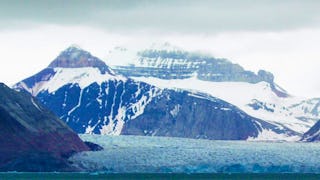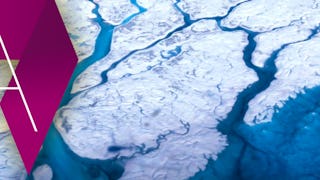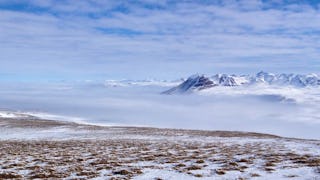The University of Alberta, the University of Tromso and the University of the Arctic invite you to explore this four week course that examines the environment and climate of the circumpolar North. This course is the result of an international collaboration and provides you with an insight into our planet's North. Following an overview of regional geography, we will focus on the cryosphere (ice), as well as the atmosphere and ocean of the region. We will learn why the Arctic is cold and ice covered, and how that impacts its climate and ecosystems. We will also consider how the Arctic is connected to the rest of the world. Finally, we will examine present day climate change, the processes driving it, and evidence for it in the Arctic, before looking at the implications in the rapidly evolving North. Watch a preview of the course here: https://uofa.ualberta.ca/courses/arctic-climate

Enjoy unlimited growth with a year of Coursera Plus for $199 (regularly $399). Save now.

Introduction to the Arctic: Climate

Instructor: Paul Myers, Ph.D
17,202 already enrolled
Included with
(512 reviews)
Skills you'll gain
Details to know
4 assignments
See how employees at top companies are mastering in-demand skills

There are 4 modules in this course
This course is about the remarkable northern regions of the earth, the Arctic! Although sometimes considered remote and dangerous, the Arctic is home to many peoples, along with the ecosystems that they coexist with. Researchers from many fields, both scientists and non-scientists, study this vast circumpolar region to understand the environment, peoples, animals, economies, and resources. You’ll soon learn about the environments (the characteristics of the natural world) and climate (the prevailing atmospheric, oceanic and ice conditions) of the world’s North.
What's included
4 videos6 readings1 assignment
In this lesson we’ll learn about the climate of the Arctic, and the way the climate interacts with the rest of the Earth system. In Lesson 1, we saw how the Earth receives energy from the sun and how heat is trapped on our planet through the natural greenhouse effect. We will now discuss how this energy is distributed throughout the globe and how it is transferred from the tropics to the poles via the large-scale circulation systems of the atmosphere and the ocean. We’ll learn the difference between the natural and the human-induced greenhouse effect - driven by the input of greenhouse gases created by burning fossil fuels, such as carbon dioxide and methane - and discuss what the future holds for the Arctic’s climate. As you will see, the global climate system is tightly linked and climate change in the Arctic also strongly affects temperate latitudes.
What's included
6 videos2 readings1 assignment
In this lesson, we’ll be learning about the Arctic cryosphere, which is the portion of the Earth’s surface where water occurs in solid forms. Such as snow and ice! In Lesson 2, we talked about atmospheric and oceanic circulation. Now we will learn about when and how ice forms on the surface of the Earth, including such topics as: sea ice, river ice, glaciers , and permafrost. How all this ice formed on the ocean and on (and in) the land? How it relates to the atmosphere and ocean?
What's included
4 videos1 reading1 assignment
In this lesson, we’ll be learning about the implications of climate change. Through the first 3 lessons, we’ve learned a great deal about the Arctic environment. This environment is rapidly changing, largely due to industrial human activity throughout the world. You’ll remember the natural greenhouse effect that we discussed in Lesson 1. Carbon dioxide and water vapour are among the naturally occurring greenhouse gases in the atmosphere. They trap outgoing longwave radiation, raising the average temperature of the Earth. We will learn and discuss how sea ice and glaciers react to changes in our atmosphere and oceans. We will then discuss the implications of the changing environment on ecosystems, wildlife and humans.
What's included
4 videos1 reading1 assignment
Instructor

Offered by
Explore more from Environmental Science and Sustainability
 Status: Free Trial
Status: Free TrialUniversity of Colorado Boulder
 Status: Preview
Status: PreviewÉcole Polytechnique Fédérale de Lausanne
 Status: Free
Status: FreeUniversity of Alberta
 Status: Free Trial
Status: Free TrialUniversity of Colorado Boulder
Why people choose Coursera for their career




Learner reviews
512 reviews
- 5 stars
68.94%
- 4 stars
22.26%
- 3 stars
5.46%
- 2 stars
1.95%
- 1 star
1.36%
Showing 3 of 512
Reviewed on May 16, 2020
This course was great, but I can't find the other UArctic courses mentioned, particularly the one about Arctic Cultures! I would love to learn more, any info would be much appreciated!
Reviewed on Apr 24, 2016
I found the course informative, but the quizzes to be a problem as there were too many multiple answers, so was near impossible to complete the quizzes correctly
Reviewed on Jan 31, 2022
It was a really interesting course and I learnt something knew as well, which wasn't covered in my University curriculum. I was happy to attend and complete this course from the beginning to the end.

Open new doors with Coursera Plus
Unlimited access to 10,000+ world-class courses, hands-on projects, and job-ready certificate programs - all included in your subscription
Advance your career with an online degree
Earn a degree from world-class universities - 100% online
Join over 3,400 global companies that choose Coursera for Business
Upskill your employees to excel in the digital economy
Frequently asked questions
To access the course materials, assignments and to earn a Certificate, you will need to purchase the Certificate experience when you enroll in a course. You can try a Free Trial instead, or apply for Financial Aid. The course may offer 'Full Course, No Certificate' instead. This option lets you see all course materials, submit required assessments, and get a final grade. This also means that you will not be able to purchase a Certificate experience.
When you purchase a Certificate you get access to all course materials, including graded assignments. Upon completing the course, your electronic Certificate will be added to your Accomplishments page - from there, you can print your Certificate or add it to your LinkedIn profile.
Yes. In select learning programs, you can apply for financial aid or a scholarship if you can’t afford the enrollment fee. If fin aid or scholarship is available for your learning program selection, you’ll find a link to apply on the description page.
More questions
Financial aid available,

